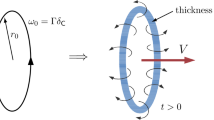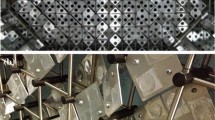Abstract
We here report results obtained from numerical simulations of the TaylorGreen three-dimensional vortex flow. This flow is perhaps the simplest system in which one can study the generation of small scales by three-dimensional vortex stretching and the resulting turbulence. The problem is studied by both direct spectral numerical solution of the Navier-Stokes equations (with up to 2563 modes) and by power series analysis in time.
The inviscid dynamics are strongly influenced by symmetries which confine the flow to an impermeable box with stress-free boundaries. There is an early stage during which the flow is strongly anisotropic with well-organized (laminar) small-scale excitation. The flow is smooth but has complex-space singularities within a distanceδ(t) of the real space which are manifest through an exponential tail in the energy spectrum. It is found thatδ(t) decreases exponentially in time to the limit of our resolution. Indirect evidence is presented that more violent vortex stretching takes place at later times, possibly leading to a real singularity (δ=0) at a finite time. These direct integration results are consistent with new presented results extending the Morf, Orszag, and Frisch temporal power series analysis from order t40 to order t80. Still, convincing evidence for or against the existence of a real singularity will require even more sophisticated analysis.
The viscous dynamics (decay) have been studied for Reynolds numbersR (based on integral scale) up to 3000 and beyond the time tmax at which the maximum energy dissipation is achieved. Early time, highR dynamics are essentially inviscid and laminar. Then, instabilities starting at small scales, which may be driven by viscosity, make the flow increasingly chaotic (turbulent) with extended high-vorticity patches appearing away from the impermeable walls. Neart max the small scales of the flow are nearly isotropic providedR>1000. Various features characteristic of fully developed turbulence are observed neart max whenR=3000.
Similar content being viewed by others
References
E. N. Lorenz,J. Atmos. Sci. 20:130 (1963); D. Ruelle and F. Takens,Commun. Math. Phys. 20:167 (1971);23:343(E) (1971).
A. N. Kolmogorov,C. R. Acad. Sci. USSR 30:301 (1941).
G. K. Batchelor and A. A. Townsend,Proc. R. Soc. London Ser. A 199:238 (1949).
A. N. Kolmogorov,J. Fluid Mech. 13:82 (1962).
B. Mandelbrot, inTurbulence and Navier-Stokes Equation, R. Temam, ed., Lecture Notes in Mathematics, Vol. 565 (Springer, Berlin, 1976), p. 121.
U. Frisch, P. L. Sulem, and M. Nelkin,J. Fluid Mech. 87:719 (1978).
U. Frisch, in Les Houches, Session XXXVI,Chaotic Behaviour in Deterministic Systems, 1981, G. Iooss, R. H. G. Helleman, and R. Stora, eds. (North Holland 1983).
R. H. Kraichnan,Phys. Fluids 10:2080 (1967).
U. Frisch and R. Morf,Phys. Rev. A 23:2673 (1981).
P. G. Saffman in:Topics in Non-Linear Physics, N. Zabusky, ed. (Springer, Berlin, 1968), p. 485.
G. I. Taylor and A. E. Green,Proc. R. Soc. London Ser. A 158:499 (1937).
M. E. Brachet, D. I. Meiron, S. A. Orszag, B. G. Nickel, R. H. Morf, and U. Frisch,J. Fluid Mech. 130:411 (1983).
R. H. Morf, S. A. Orszag, and U. Frisch,Phys. Rev. Lett. 44:572 (1980).
R. H. Morf, S. A. Orszag, D. I. Meiron, U. Frisch, and M. Meneguzzi, inProc. 7th Intl. Conf. on Numerical Methods in Fluid Dynamics, R. W. McCormack and W. C. Reynolds, eds., Lecture Notes in Physics, Vol. 141 (Springer, Berlin, 1981), p. 292.
W. Wolibner,Math. Z. 37:698 (1933).
G. A. Baker,Essentials of Padé Approximants (Academic, New York, 1975).
M. E. Fisher and M. Au-Yang,J. Phys. A 12:1677 (1979);13:1517 (1980).
C. Sulem, P. L. Sulem, and H, Frisch,J. Comp. Phys. 50:138 (1983).
Y. F. Chang, M. Tabor, and J. Weiss,J. Math. Phys. 23:531 (1982).
J. Weiss, Analytic Structure of Hénon-Heiles System, inMathematical Methods in Hydrodynamics, A.I.P. Conf. Proc. No. 88 (AIP, New York, 1982).
A. S. Monin and A. M. Yaglom,Statistical Fluid Mechanics Vol. 2 (MIT Press, Cambridge, Massachusetts, 1975).
Author information
Authors and Affiliations
Additional information
Work supported by the NSF under grants Nos. ATM-8017284 and DMR-77-10210; by the Office of Naval Research under Contracts NOOO14-77-C-0138 and NOOO14-79-C-0478; by the NSERC of Canada; and by the A. P. Sloan Foundation.




